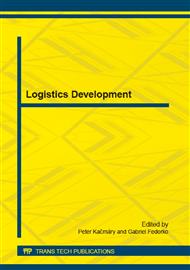[1]
T. Chovan, M. Straka, The allocation and layout of power generators for the needs of electric cars in Košice, TU Košice, Košice, 2012. (original in Slovak).
Google Scholar
[2]
Information on http: /futuremotion. cz/cs/futuremotion/elektromobilita. html(Original in Czech).
Google Scholar
[3]
D. Cagáňová, M. Čambál, S. WeidlichováLuptáková, Intercultural Management – Trend of Contemporary Globalized World, Electronics and Electrical Engineering, Technologija, Kaunas. 6-102 (2010) 51-54.
Google Scholar
[4]
P. Danišovič, M. Hodoň, M. Chovanec, Intelligent traffic-safety mirror by using wireless sensor network, Acta Logistica. 1-1 (2014) 19-21.
DOI: 10.22306/al.v1i1.12
Google Scholar
[5]
Information on http: /www. hybrid. cz (original in Czech).
Google Scholar
[6]
R. Kampf, P. Průša, C. Savage, Systematic location of the public logistic centres in Czech Republic, Transport. 26-4 (2011) 425-432.
DOI: 10.3846/16484142.2011.635424
Google Scholar
[7]
A. Rosová, Logistics costs of the enterprise, Acta Montanistica Slovaca. 12-2 (2007) 121-127.
Google Scholar
[8]
Information on http: /www. vse. sk(Original in Slovak).
Google Scholar
[9]
P. Ceniga, V. Šukalová, Future of logistics and globalization, Globalization and its social-economic consequences ´13. (2013) 62-68.
Google Scholar
[10]
P. Marianyi, Electric age is finitely in the offing, Revue priemyslu. 9 (2009) 50-51. (original in Czech).
Google Scholar
[11]
S. Golak, D. Burchart-Korol, K. Czaplicka-Kolarz, T. Wieczorek, Application of Neural Network for the Prediction of Eco-efficiency, in: D. Liu et al. (Eds. ), Computer Science Part III, LNCS 6677, Springer-Verlag, Berlin Heidelberg, 2011, pp.380-387.
DOI: 10.1007/978-3-642-21111-9_43
Google Scholar
[12]
P. Besta, A. Samolejová, K. Janovská, M. Lampa, R. Lenort, Evaluation of benefits resulting from innovation of input raw materials dosing process in sintering, Metalurgija. 51-4 (2012) 457-460.
Google Scholar
[13]
K. Witkowski, S. Saniuk, Aspect of logistics management of the city infrastructure, Logistyka. 41-2 (2011) 589-600.
Google Scholar
[14]
J. Šaderová, P. Kačmáry, The simulation model as a tool for the design of number of storage locations in production buffer store, Acta Montanistica Slovaca. 18-1 (2013) 33-39.
Google Scholar
[15]
R. Winkler, Effectiveness - an attempt about conceptualization of the idea, Zeszyty Naukowe Uniwersytetu Ekonomicznego w Krakowie. 820 (2010) 105-117.
Google Scholar
[16]
S. Saniuk, A. Saniuk, R. Lenort, A. Samolejova, Formation and planning of virtual production networks in metallurgical clusters, Metalurgija. 53-4 (2014) 725-727.
Google Scholar
[17]
I. Leššo, P. Flegner, M. Laciak, K. Feriančiková, Hilbert spaces as an efficient instrument for signal processing in geotechnics application of vector quantisation method, 12th International Carpatian Control Conference (IEEE). (2011) 253-256.
DOI: 10.1109/carpathiancc.2011.5945857
Google Scholar
[18]
P. Trebuňa, J. Halčinová, Mathematical Tools of Cluster Analysis, Applied Mathematics. 4-5, (2013) 814-816.
DOI: 10.4236/am.2013.45111
Google Scholar
[19]
A. Rosová, A., M. Balog, Ž. Šimeková, The use of the RFID in rail freight transport in the world as one of the new technologies of identification and communication, Acta Montanistica Slovaca. 18-1 (2013) 26-32.
Google Scholar
[20]
G. Fedorko, E. Stanova, V. Molnár, N. Husáková, S. Kmet, Computer modelling and finite element analysis of spiral triangular strands, Advances in Engineering Software. 73 (2014) 11-21.
DOI: 10.1016/j.advengsoft.2014.02.004
Google Scholar
[21]
S. Saniuk, A. Saniuk, Rapid prototyping of constraint-based production flows in outsourcing, Advanced Materials Research. 44-46 (2008) 355-360.
DOI: 10.4028/www.scientific.net/amr.44-46.355
Google Scholar
[22]
E. Loučanová, A. Zaušková, Identification the cluster woodprocessing sector in the Slovak republic, in: Intercathedra. 23 (2007) 61-66.
Google Scholar
[23]
P. Trebuňa, M. Kliment, M. Fiľo, J. Markovič, J. Halčinová, PLM systems, their history and application today in business process modeling, Mechanics, Scientific researches and methodical development. 7 (2013) 129-133.
Google Scholar
[24]
R. Bednár, H. Vidová, M. Beluský, Lean principles application in business logistics, 21st International Conference on Metallurgy and Materials (METAL). (2012) 6.
Google Scholar


